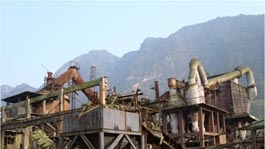The Wenchuan Earthquake in Sichuan in China was a major catastrophe that led to more than 87,000 deaths, destroyed homes of more than 5 million people, and produced direct economic losses of $120 billion. The World Bank was please to be part of China’s immediate responsiveness and the successful coordination of national and international disaster relief. Much has been accomplished in the year and a half since the earthquake, but nevertheless, much remains to be done. One major task to be carried out is the environmentally sound management of hazardous chemicals and wastes generated by the earthquake.
Immediately after the earthquake occurred, a project on Rapid Assessment of Chemical Contamination of the Wenchuan Earthquake (financed by the Global Environment Facility (GEF), supervised by the World Bank and implemented by the Ministry of Environment (MEP) and Sichuan Environmental Protection Bureau (EPB) of China), made initial efforts to assess risks associated with chemical wastes, with a particular focus on chemical and waste storage facilities that may have been weakened by the earthquake. This rapid assessment proposed measures to mitigate the risks that were identified, and the appropriate investments are now being made wherever possible.
The GEF Rapid Assessment Project was prepared and implemented as a part of a MEP Program on Post Wenchuan Earthquake Environmental Safety Assessment and Countermeasures initiated on June 3, 2008. The project supported China’s emergency responses to the Wenchuan Earthquake by assessing potential environmental impacts and risks associated with the releases of hazardous chemicals and waste in five hard-hit counties in Sichuan Province. Implementation of the GEF project was concluded successfully in October 2009. The project supported three phases of activities: identification of pollution sources, rapid assessment of the highest priority sources, and recommendation on risk mitigation. Throughout the three phases, project related information was disclosed through internet and other platforms.
Shortly after project completion, a knowledge management workshop financed by the Canadian International Development Agency through the World Bank, was held on December 3 and 4, 2009 in Chengdu, the capital city of Sichuan. The workshop shared the lessons learned, particularly concerning disaster risk management. The workshop was to ensure that the knowledge gained is incorporated into disaster risk plans produced in other earthquake zones in China, and is available to experts working in other countries. About 100 participants from MEP, affected provinces (Sichuan, Gansu, Shaanxi, Yunnan Province and Chongqing City), USEPA, consulting firms, and the World Bank task team attended the workshop. The workshop proved participants a lively exchange of forward looking ideas and the sharing of key global expertise on post-disaster risk, reconstruction, and clean-up.
At the workshop, the Bank’s rapid preparation of the GEF project was highly appreciated by its government partner. “The GEF project was prepared and approved by the World Bank within only one month, which was record breaking and showed what is truly meant by rapid response,” said Yu Lifeng, Deputy Director General of the Foreign Economic Cooperation Office of MEP, the domestic implementing agency of the project.
“The rapid processing of this GEF project reflects the Bank’s commitment to support our clients when they need us most urgently,” concurred by Ede Jorge Ijjasz-Vasquez, World Bank’s Sector Manager for Sustainable Development for China and Mongolia.
The workshop participants also visited the abandoned production facility of Sichuan Hongda Prosperous Chemical Industry Co. Ltd. at Chuanxindian, Shifang City to gain first hand understanding of the daunting task faced by the province on hazardous disaster waste management. The plant had been completely destroyed and was identified as a high risk pollution source. This plant is only one of many industrial sites destroyed by the earthquake.
Intensive sampling and monitoring were undertaken with assistance of portable equipment procured under the project. The project has been seen as a rapid response model and effort characterized by partnership and trust. Mr. Li Heyi, chief engineer of Sichuan Provincial Environmental Protection Bureau noted that “the World Bank managed GEF project has played an important part in ensuring that there was no major secondary environmental accident in Sichuan after the Wenchuan Earthquake.”
The project succeeded in screening 346 sites with potential chemical contamination risks and identifying 58 priority pollution sources for follow-up mitigation actions. As the province seeks ways to fully clean up these potential hazards, it is expected that mitigation activities proposed by the GEF project will be included in Sichuan’s future post-disaster recovery and reconstruction actions, supported by the Bank’s emergency recovery loan. Additional GEF resources for mitigation actions are also being requested.
The GEF project is a small but integral part of the Bank’s overall quick response to the Wenchuan Earthquake. In addition, the Bank has provided an emergency recovery loan, and other grants and technical advice on post-earthquake recovery and reconstruction.

